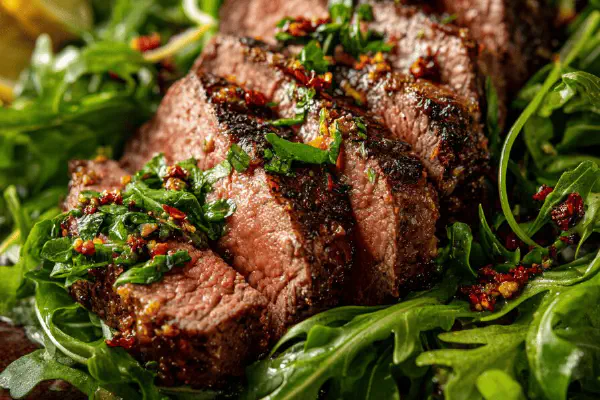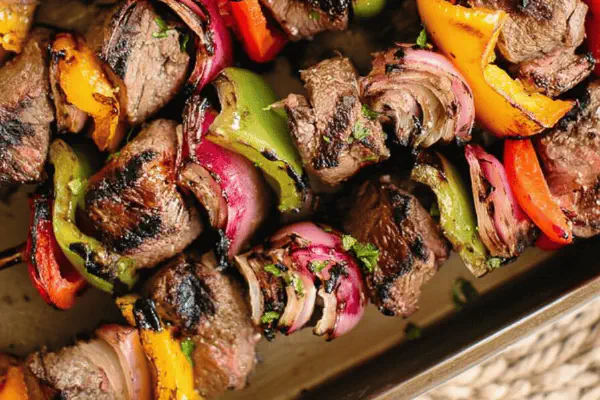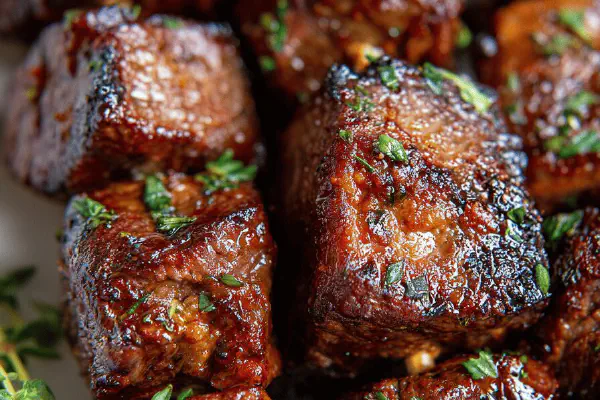Beef Tataki Remix

By Emma
Certified Culinary Professional
Ingredients
Marinade
- 2 green onions thinly sliced
- 50 ml (about 3 tablespoons plus 1 teaspoon) rice vinegar
- 25 ml (1 tablespoon plus 2 teaspoons) soy sauce
- 15 ml (1 tablespoon) finely grated fresh ginger
- 15 ml (1 tablespoon) finely chopped lemongrass
- 5 ml (1 teaspoon) harissa paste
Tataki
- 1 piece of about 350 g (12 oz) beef tenderloin
- 25 ml (1 tablespoon plus 2 teaspoons) olive oil
- 40 ml (just under 3 tablespoons) mayonnaise
- Fresh arugula or baby kale leaves
About the ingredients
Method
Marinade
- Mix green onions, rice vinegar, soy sauce, ginger, lemongrass, and harissa in a glass bowl or a sealable plastic bag. Stir well to break up the harissa paste so it disperses.
Tataki
- Heat a heavy skillet on high flame until it's shimmering hot. Add olive oil and swirl. Sear beef tenderloin on all sides quickly. Look for a deep brown crust forming; it should sizzle loudly but not smoke excessively—usually 3 to 4 minutes total. Don't cook through; the inside stays raw.
- Rest the meat at room temp about 5 minutes—juices settle, and carryover cooking stops. Then submerge it in marinade. Coat the meat well, cover, refrigerate at least 5 hours, ideally overnight for max infusion.
- When ready, remove meat. Strain marinade to remove solids. Reserve clear liquid.
- Mix mayonnaise with 30 ml of the reserved marinade to make a tangy aioli. Stir till smooth.
- Using a sharp knife, slice the beef thinly across the grain—this ensures tenderness and precise texture. Arrange slices on plates atop fresh arugula or baby kale.
- Drizzle with the aioli. Optionally, garnish with extra green onions or sesame seeds for texture and aroma.
Cooking tips
Chef's notes
- 💡 Heat skillet till just shimmering hot; watch oil swirl, thin veil on pan. No smoking but close. Sear beef fast, about 1 min per side. Look for deep brown crust that crackles but doesn’t burn or smoke. Raw center key; rest meat to settle juices. Warm pan, quick timing crucial to keep that rare interior texture.
- 💡 Marinate fully submerged; use a bag to press close against beef. Air gaps slow infusion. Five hours minimum, overnight best for flavor depth. Strain before use—solids clog sauce texture, make aioli gritty. Save marinade; boil leftover for sauce drizzle on rice or veg. Acid balance varies by vinegar type; adjust if subbing apple cider or mirin.
- 💡 Use fresh ginger and lemongrass only. Dried versions dull flavor; no swap here. Harissa gives smoky heat, different from sambal’s sharp punch. If heat’s too much, reduce paste quantity, or swap for less spicy chili pastes. Olive oil preferred for searing flavor but grapeseed or canola work with hotter smoke points if pans run hotter.
- 💡 Aioli blend needs smooth texture; whisk vigorously. Mix reserved marinade slowly to avoid curdling mayo. Add lemon zest if you want brightness lift but keep subtle. Slicing meat cold helps thin, clean cuts that hold shape. Warm slices tear and look rough, less appealing. Plate atop fresh peppery greens to cut richness; arugula wins over baby kale in pungency.
- 💡 Listen carefully to sizzle—the bark forms fast. If sizzle quiets too soon, pan lost heat. Reset flame, remove meat till pan ready again. Resting the meat after sear crucial. Fibers relax, juice redistributes; skip and meat dries. Drizzle aioli close to serving so greens don’t wilt. Garnish with toasted sesame or green onion for aroma and crunch contrast.
Common questions
How hot should the pan be?
Shimmering oil but no smoke. Hot enough meat sizzles immediately. If oil smokes, cool pan down. Sizzle stops means pan too cool. Try test sear corner piece first.
Can I swap the harissa?
Yes, but heat and flavor shifts. Sambal oelek for sharper chili. Or mild chili paste if low spice wanted. Harissa adds smokiness unique though, no exact match.
What if meat overcooks?
Over searing kills rare texture. Cut thinner slices, chill meat before slicing. Resting helps retain juices. If dry, try shorter sear or higher temp with faster cooking. Alternate cuts like sirloin more forgiving if sliced thin and rare.
How to store leftovers?
Wrap tightly; best used within a day for texture. Marinade separate and boil before reuse. Greens best fresh to retain crispness. Aioli stored cold, avoid long sit out. Can freeze beef sliced but loses texture slightly.



